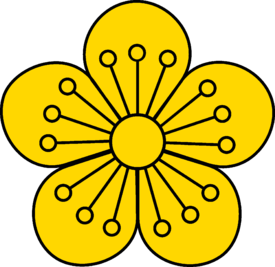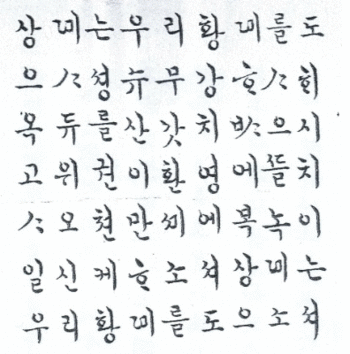National anthem of the Korean Empire
| English: "Korean Empire Aegukga" | |
|---|---|
| "Daehan Jeguk Aegukga" | |
|
The imperial seal of the Greater Korean Empire | |
|
National anthem of | |
| Also known as |
English: "Anthem of the Korean Empire" |
| Lyrics | Min Young Hwan, 1902[1] |
| Music | Franz Eckert, 1902 |
| Adopted | 1902 |
| Relinquished | 1910 |
| National anthem of the Korean Empire | |
| Hangul | 대한제국 애국가 |
|---|---|
| Hanja | 大韓帝國 愛國歌 |
| Revised Romanization | Daehan Jeguk Aegukga |
| McCune–Reischauer | Taehan Cheguk Aegukka |
The "Anthem of the Greater Korean Empire" (Hangul: 대한제국 애국가; Hanja: 大韓帝國 愛國歌; literally "Korean Empire Aegukga") was the anthem of the Korean Empire, used in the early 20th century. It was the first national anthem of a unified Korean state.
History
The anthem was first commissioned by Emperor Gojong in 1901 and presented to the Korean court on 1 July 1902, by German composer Franz Eckert, who was the director of the Korean Empire's military band at the time.[2] It was published in Germany in five different languages (Korean, German, English, Chinese, and French) and performed for the first time on 9 September 1902, during Emperor Gojong's birthday ceremony.[3]
The imminent demise of the Korean Empire's independence, however, meant that the anthem did not become widely available. With the signing of the Eulsa Treaty in 1905, the Korean Empire was well on its way towards annexation by the Empire of Japan.
Lyrics (monarchist version)
| Original Korean | English | Modern Korean translation |
|---|---|---|
|
|
|
하늘이시여, 우리 황제를 도우소서 |
It was the original version made for Gojong Emperor.[4]
Lyrics (Republican version)
The republican lyrics were re-discovered on 13 August 2004, by curator Lee Dong-guk of the Seoul Calligraphy Art Museum.[5] The surviving specimen was a copy kept by the Korean-American Club of Honolulu-Wahiawa and published in 1910 under the title Korean old national hymn in English and 죠션국가 in Korean.[5][6][7]
The discovery came as a surprise even in South Korea, where the existence of the republican lyrics was unknown until then. The finding was later reported in the mass media and has since then been performed by various K-pop artists. Hawaii has been a source for various pre-Japanese annexation heritage investigations by South Korea since many Korean Empire citizens emigrated to Hawaii before the Japanese annexation. One recent incident involved a Korean Empire émigré descendant donating a very rare 100-plus-year-old original passport issued by the Korean Empire to South Korean president Roh Moo-hyun during his visit to Hawaii.
The republican lyrics are:
| republican Korean with hanja added | Romanisation (Yale) | English | Modern Korean translation |
|---|---|---|---|
|
샹뎨(上帝)는 우리 나라를 도으소셔 |
syā:ngtyeynun wuli na:la lul twou:swosye |
God help our nation |
하늘이시여, 우리 나라를 도우소서 |
In the romanisation, ‹:› indicates length marks for singing that appear in the source; ˉ marks vowels that would have been pronounced as long vowels when not singing. While the copy appearing in the source () appears markedly newer than the 1900s and calls the anthem the “Joseon national anthem” (죠션 국가) instead of “Patriotic song of the Korean Empire” (大韓帝國愛國歌) as one would expect from a 1900s original, it clearly shows pre-1933 orthography (reproduced here) that was not used after the 1940s.
See also
References
- ↑ "Anthem of the Korean Empire". NationalAnthems.
- ↑ Naver News Article (in Korean)
- ↑ http://news.naver.com/news/read.php?mode=LSD&office_id=032&article_id=0000079590§ion_id=103&menu_id=103
- ↑ KOREA DATABASE AGENCY
- 1 2 (Korean) Chosun.com 카페
- ↑ Naver News
- ↑ Blog regarding the KBS-TV broadcast of Korean Empire Anthem


